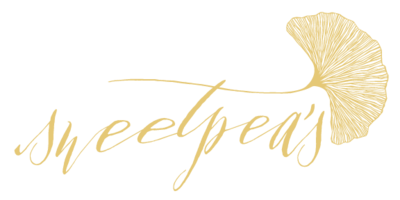Where Do Our Flowers Come From?
Where do our flowers and greens come from?
Sweetpea's is open and honest about the origins of all their floral and greenery material. We were one of the first eco and socially responsible florists in the city, which has been our mandate from day one.
We do everything possible to reduce our footprint. This is all encompassing. From eco to social.
Our product comes from a combination of local growers, as well as eco and socially responsible farms from throughout Canada, the US and overseas.
Sweetpea's prides itself on keeping a beautiful selection of blooms in stock, year round. When buying, our suppliers often joke that they can tell our selections over others, because we are drawn to the unusual. This can be new and interesting varieties of roses, to tropicals we have to Google just to figure out what exactly we are looking at. It is what keeps our designs constantly changing and provide the diversity of styles our customers have come to depend on.
Locally Grown is Great, but also Limiting
Ontario is one of the largest cut flower producers in North America. We grow 50% of the cut flowers in Canada. This includes over 80 varieties of fresh flowers and 120 varieties of potted plants. That's very impressive.
However .... there are limitations.
During the summer months, Sweetpea's uses as much local product as possible. It is, without a doubt, our favourite time of year as florists. There is a wide diversity of amazing growers, with a level of quality and freshness we always strive for.
We are always cautious of buying from trusted, established growers, who have proven their quality and longevity, while still being considerate of the price constraints we place on ourselves to ensure we continue to meet your expectations.
I have had the pleasure of visiting many Ontario growers, from small, local farms, using hot houses and their open fields, to large scale commercial greenhouse operations. The dedication involved in flower growing is a unique level of farming that earns a high level of respect from the entire floral industry. This is a labour of love. There is no doubt about that.
Within Ontario Growers, there are great, dependable flower varieties available year-round, but once that prime growing season is over, we are completely dependant on greenhouse growers. This limits availability and diversity. There are also industry standards that are best grown overseas, including hydrangea, roses, carnations, and tropicals.
"Import" is Not a Dirty Word
As the owner of Sweetpea's, and the primary floral purchaser, I have always been very forthcoming about our use of imported items and the efforts we have gone through to find growers and suppliers that will work within our sensibilities.
We have worked closely with our suppliers to learn about the various growers and their sustainability programs.
The growers we buy from are primarily in Ecuador and Colombia.
These growers have their certifications from a variety of sources, including, but not limited to,
The farms have policies and programs in place for all levels of eco and social responsibility. These include land/resource sustainability, reforestation of their farms (which were previously 'green deserts'), water conservation, pest control, and compost management.
Their workforces promote equality with 46% of their workers being women. They offer education and literacy programs, medical care, child care and safety protocols. Some farms also offer housing for their team members.
These are state of the art facilities that far exceed anything possible in Canadian climates. The quality of flowers produced is unsurpassed. Often I am asked about the carbon footprint importing vs. local farming. If grown locally, the energy and water use required to create artificial growing conditions equal to what is possible in Ecuador and Colombia would far surpass what is involved in transporting from overseas.
To reiterate the level of sustainability, one grower proudly boasts that their boxes for transport are made from the waste from their own farms.
We encourage you to learn more. Please visit some of our grower's websites to see for yourself what their farms are doing in terms of sustainability.
But, What About the Carbon Footprints of Imports?
The carbon footprint of importing flowers from areas with ideal growing conditions for the varieties brought in, are less than attempting greenhouse grown flowers in Ontario. The fluctuations throughout the year in terms temperature create a variety of challenges. This can include both heat and cooling, depending on the crop. Lighting, watering, fertilizing, etc all play a part, all adding to the stress on our resources.
My Personal Soapbox*
* Please note, these are my own views and may not reflect the sentiments of my team. I am passionate about the purchasing of flowers and feel we have a responsibility to our customers to be open and honest in our sourcing of material.
"100% Locally Grown Flowers"
One of my biggest issues with the current Toronto floral industry are florists who make claims of using “100% Locally Grown Flowers” and throw around terms like, “Grown, Not Flown". What they fail to mention is that many, if not all, of their floral greens come from outside the province and country.
The majority of floral foliage is imported from the West Coast, US or Overseas. This includes salal, eucalyptus, ruscus, various ferns (tiki, leather-leaf, ming, etc), pittosporum, and the very popular, large, fluffy pampas grass.
These greens are commonly seen in the arrangements boasting "100% Locally Grown Flowers". Although technically true, is it entirely ethical to make these claims to a public that may not understand the intricacies of such a unique industry?
I feel this does a disservice to consumers, who depend on florists to inform them on the origins of their products. I believe this misrepresents a key piece of information for consumers unaware of the intricacies of a complicated and unique industry.
Regarding "Foraging":
I can assure you, as the owner of Sweetpea's, my opinions on foraging has not won me any popularity contests in the industry. We know that several florists, who depend on foraging within their genre and style, feel differently and have voice their own opinions on the subject. However, I continue to stand by my previously posted statements on various social media formats.
For those who don't know what 'Foraging' means, this is a practice where floral and fauna are harvested from various areas, which can include, but are not limited to, forest areas, private land, abandoned properties, roadsides, etc.
When it comes to foraging, I think about the long term impact of improper pruning (techniques and time of year), introduction of invasive species into our city compost system and other unmentioned repercussions. It is not something I can support, just because it is popular and trendy.


